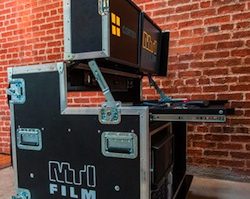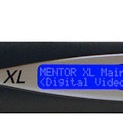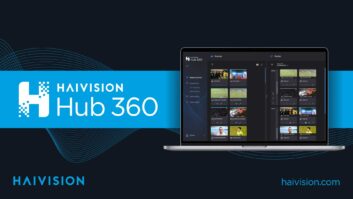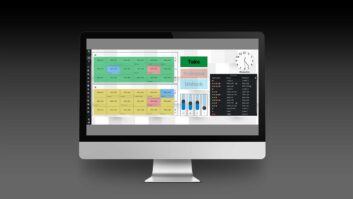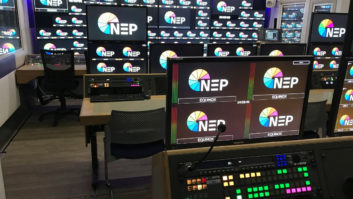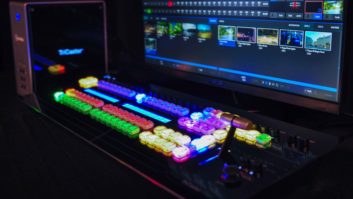
Broadcasters have been developing the concept of remote productions for some time but now the technology is fulfilling its promise to deliver more content with less resource.
High-quality live content holds the key to a loyal audience, but live production is resource intensive and traditional OB production limits the amount of content broadcasters can bring to their audience. Remote production effectively removes bottlenecks in live production workflows for delivery of more live content with better quality for less.
The most obvious way to streamline the cost of live event production is to reduce the burden of its most expensive resource: the facilities required to capture, process and produce at a venue and the engineers needed to set-up, operate and manage it.
If live broadcasts can be done at a distance from the actual event, by sending raw camera feeds, audio, and equipment control over a telecoms infrastructure to a central studio facility, then opex and capex savings will increase.
As far back as the 2012 London Olympics, Swedish broadcaster SVT used remote production and managed to send more reporters, commentators and talent to the venue. By doing so, the amount of content SVT produced nearly doubled. With the same budget, 1,600 hours of live content was produced versus 850 hours compared to the previous Olympics.
In Rio four years later, Switzerland’s SRG SSR, the joint central production and broadcasting association for the nation, controlled studio operations from three locations in Switzerland.
Initially introduced around major one-off events, remote production applications are now routine for week in week out sports broadcast. Danish broadcaster TV 2 Denmark, for example, decided to launch sports channel TV 2/Sport in 2015 only after it was satisfied it could enable parallel productions of the hugely popular handball league at multiple different arenas across the country – at the same time as reducing production costs.
Since then, TV 2 – like SVT – has performed hundreds of remote productions over Wide Area Network. Each TV 2 production requires just seven technicians to be located on-site. This means that the scarce and highly specialised production staff are used centrally, able to cover multiple events per day. In the same way, production equipment can be used more efficiently from a central facility instead of being tied up during transport between venues.
Barriers to remote
Remote production would appear a win-win for all parties. Yet there are still barriers to widespread adoption. Perhaps the biggest is breaking down cultural and workflow perceptions within the industry. These include:
Low end-to-end delay. As control of the production is accomplished some distance from the event, delay must be low to allow for a natural interaction and control.
Bandwidth efficiency. Multiple camera feeds must be transported off the venue using telecommunication capacity which is normally expensive – more so for 4K/UHD.
Maintained synchronicity. To facilitate clean and frame accurate switching, audio and video signals need to be in perfect synch when they enter the central production studio.
Fault detection and response. There is still anxiety about the ability of technology to function if multiple expert technicians are not on site to monitor or solve an issue.
Total control, high quality, low cost
Together with its customers, including SVT and TV 2 Denmark, Net Insight has overcome these barriers. The Net Insight Nimbra platform comes with JPEG2000 compression, providing very high quality compression and offering the best possible trade-off between bandwidth utilisation and low delay. The extreme low-latency affords smooth slow motion, graphics, editorial production and precise CCU camera control over many kilometres from the venue. By using JPEG2000 compression, the cost of network capacity should not be prohibitive for remote live 4K production. In fact, remote production is perhaps the most significant enabler for live 4K productions.
Coupled with this is quality of service assurance. Net Insight doesn’t leave network control unchecked in the hands of the service provider. It measures every aspect of the network performance and help broadcasters identify any problem (as Net Insight did for SRG SSR from Rio to Zurich) even before the telecoms provider is aware of the issue.
Perhaps most importantly, a single Nimbra platform provides all the video, audio and data connections needed to produce remotely over IP. It onboards a multi-service media transport platform supporting both native video and audio over IP (ST 2022-6 with ST 2110 primed for release), intercom and tally. Whatever you plug-in on one side you can control from the other. Operation is that simple.
Remote audio mixing simplicity
And Net Insight has gone one step further. While most of the focus on remote production to date has been on video, audio has been unfairly neglected given the much more complex set of sources to manage on-site from commentary and pitch-side reporters to atmospheric mics and on-camera mic. Typically, a team of technicians is required to set up multiple embedders and de-embedders with different interfaces. It’s not only time consuming, it means there are many more points in the chain where faults can occur.
A new integration of Nimbra with Calrec Audio’s RP1 Remote Broadcast unit takes away all of this pain. Net Insight has worked with Calrec Audio to develop a system allowing audio from a remote venue to be controlled in a studio many miles away, saving money on set-up time, crew, logistics, and equipment. The paired solution is very easy to use and provides assured no-latency audio processing from any venue to any production base taking care of whatever audio interface is required on site; AES, MADI, SDI, and the latest AoIP solutions from AES67 and SMPTE 2022.
It is this provision of simple connectivity, quality assured transport, precise control of audio mixes all with reduced footprint that broadcasters need.
All the keys are in place to unlock the full potential of remote production.
ByLarissa Goerner, strategic product manager at Net Insight (pictured)

